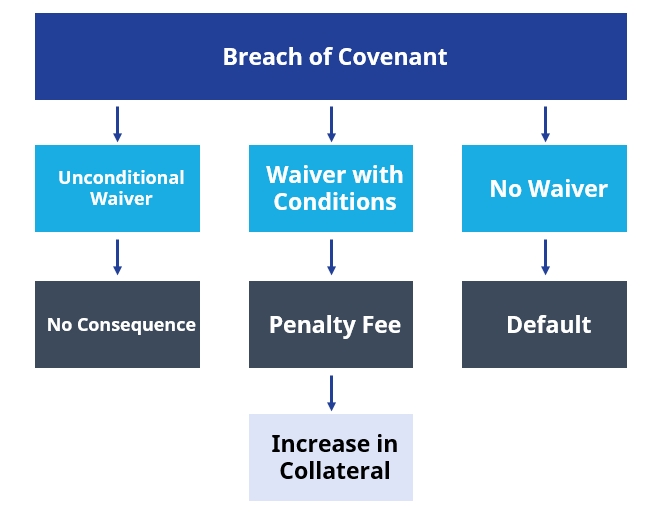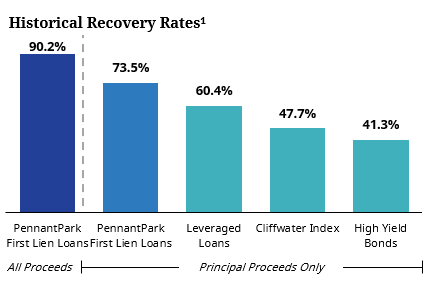Approximately 90% of loans underwritten today are considered “covenant-lite”1. Covenant-lite deals expose the lender to increased risks as the lender has limited protections in place to ensure that their loan repayment is fulfilled and prioritized. This is particularly problematic in a rising or high-rate environment.
A loan covenant is a protective agreement made between a borrower and a lender outlined in a credit agreement contract. A covenant outlines behaviors or actions that a borrower must follow to comply with the terms of a loan. Covenants are used to protect the lender, align incentives between both parties and reduce risks. If the borrower violates a covenant, the lender has certain rights, such as imposing penalty fees, increasing the loan’s interest rate, increasing the collateral behind the loan, or even terminating the loan agreement.

The upper-middle market and broadly syndicated loan space has grown rapidly over the last several years, resulting in increased competition amongst lenders. With increased competition, managers have less power to negotiate favorable terms. As a result, approximately 90% of loans underwritten today are considered “covenant-lite”1. Covenant-lite deals expose the lender to increased risks as the lender has limited protections in place to ensure that their loan repayment is fulfilled and prioritized. This is particularly problematic in a rising or high-rate credit environment like today.
Private credit managers are typically able to secure tighter financial covenants in the core-middle market segment as there is less competition from banks and mega-fund lenders. PennantPark focuses on securing prudent terms and structural protections on every loan, including a target of at least two financial covenants for each loan.
Examples of financial covenants include:
We view covenants as imperative structural elements of credit negotiation in the core-middle market. They act as guardrails for lenders to intervene early on before serious issues arise, jeopardizing principal.
When allocating to private credit, investors need to evaluate a credit manager’s commitment to protective covenants, paying special attention to a manager’s historical loss and recovery rates. At PennantPark, we believe our focus on structural protections has contributed to our ability to withstand turbulent economic cycles, and our impressively low loss rate and high historical recovery rates, since our founding in 2007.
1 Source: Goldman Sachs Asset Management, Credit Terms: The Rising Importance of the Fine Print

We welcome a conversation; please contact invest@pennantpark.com or the professionals listed below.
The information contained in this Presentation does not constitute and is not intended to constitute an offer of securities and accordingly should not be construed as such. Any products or services referenced in this Presentation may not be licensed in all jurisdictions, and unless otherwise indicated, no regulator or government authority has reviewed this document or the merits of the products and services referenced herein. This Presentation and the information contained herein has been made available in accordance with the restrictions and/or limitations implemented by any applicable laws and regulations. This Presentation is directed at and intended for institutional investors.
Furthermore, this Presentation is provided on a confidential basis for informational purposes only and may not be reproduced in any form. Before acting on any information in this Presentation, current and prospective investors should inform themselves of and observe all applicable laws, rules and regulations of any relevant jurisdictions and obtain independent advice if required. This Presentation has been made available only for each qualified recipient’s use, and should not be given, forwarded or shown to any other person (other than the recipient’s employees, agents, or consultants).
No person has been authorized in connection with this offering to give any information or to make any representations other than as contained in this Presentation and, if given or made, such information or representation must not be relied upon as having been authorized by PennantPark Investment Advisers, LLC (“PennantPark”) or PennantPark’s affiliates. Statements in this Presentation are made as of the date hereof unless stated otherwise herein, and neither the delivery of this Presentation at any time, nor any sale hereunder, shall under any circumstances create an implication that the information contained herein is correct as of any time subsequent to such date.
An investment in the interests of any PennantPark fund is suitable only for sophisticated investors and requires the financial ability and willingness to accept the risks and lack of liquidity that are characteristic of an investment in such funds. Investors must be prepared to bear such risks for an extended period of time. There can be no assurance that any investments will be profitable, not lose money, or achieve the other intended purposes for which they are made. In particular, the risks of investing in such funds may include: 1) Lack of liquidity in that withdrawals are generally not permitted, and there is no secondary market for Interests and none is expected to develop; 2) Restrictions on transferring Interests; 3) The use of leverage; and 4) Less regulation and higher fees than mutual funds. This is not intended to be a complete description of the risks of investing in such funds. Investors should rely on their own examination of the potential risks and rewards. The Offering Memorandum will discuss these and other important risk factors and considerations that should be carefully evaluated before making an investment. Prospective investors should consult with their own legal, tax, and financial advisers as to the consequences of an investment.
Certain statements contained in this Presentation, including without limitation, statements containing the words “believes,” “anticipates,” “intends,” “expects,” and words of similar import constitute “forward looking statements.” Additionally, any forecasts and estimates provided herein are forward looking statements. Such statements and other forward looking statements are based on available information and the views of PennantPark as of the date hereof. Accordingly, such statements are inherently speculative as they are based on assumptions that may involve known and unknown risks and uncertainties. Actual results and events may differ materially from those in any forward looking statements. Further, any opinions expressed are the current opinions of PennantPark only and may be subject to change, without notice. There is no undertaking to update any of the information in this document.
Certain information contained herein concerning economic trends and performance is based on or derived from information provided by independent third party sources. PennantPark believes that such information is accurate and that the sources from which it has been obtained are reliable. PennantPark cannot guarantee the accuracy of such information, however, and has not independently verified the assumptions on which such information is based.